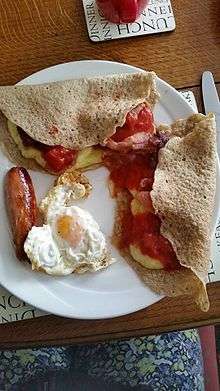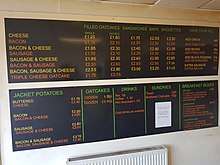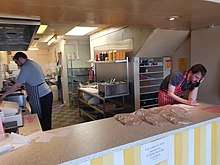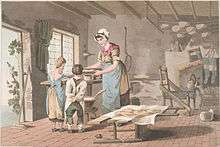Staffordshire oatcake
A Staffordshire oatcake is made from oatmeal, flour and yeast to make a dense pancake. It is cooked on a griddle, "backstone" or "baxton". The oatcake is a local speciality in the North Staffordshire area of England, specifically Stoke-on-Trent. They are normally referred to as Staffordshire oatcakes by non-locals, because they were made in and around Staffordshire and Cheshire; locally they are simply called "oatcakes".[1][2]
 A breakfast consisting of two Staffordshire oatcakes filled with cheese, tomatoes, and back bacon, served with a fried egg and a sausage. | |
| Type | Pancake |
|---|---|
| Place of origin | England |
| Region or state | Staffordshire |
| Main ingredients | Oatmeal |
History

It was once common throughout the Potteries for oatcakes to be sold directly from the window of a house to customers on the street. The last producer in this style, the "Hole in the Wall" in Stoke-on-Trent, closed on 25 March 2012; however, there are many small commercial premises who sell oatcakes, either ready to eat, with a filling, or in batches of half a dozen or a dozen for the customer to take home. Larger commercial enterprises exist that sell oatcakes to supermarkets and other large distribution chains.[3][4]

Oatcakes can be a form of fast food. Catering outlets in the area usually offer oatcakes with fillings such as cheese, tomato, onion, bacon, sausage, and egg. They can also be eaten with sweet fillings such as golden syrup, jam or banana, but this is less common and frowned upon by traditionalists. They are traditionally re-heated by steaming between two plates over a saucepan of water or nowadays by microwave, though some may prefer frying in butter or grilling.[5]
The Staffordshire oatcake is not to be confused with the Scottish oatcake (biscuit)[6][7]; although both are made from oatmeal, the two types of oatcakes are very different. The Staffordshire oatcake dates back to the 19th century where it was baked on a hotplate over an open fire.[8]
Regional variants
Derbyshire oatcakes
Derbyshire oatcakes are similar to Staffordshire oatcakes, but while following a similar (or even the same) recipe, they are generally larger in diameter and thicker. For example, a recipe that would make four Derbyshire oatcakes might generally make twelve of the Staffordshire.[9]
Lancashire and Yorkshire oatcakes
A Lancashire oatcake bears a passing resemblance to a Derbyshire oatcake, but is made without wheat flour or milk, and shaped as an approximate 11-by-6-inch (28 cm × 15 cm) oval, smooth on one side and rough on the other, and traditionally cooked on a bakestone. It may be eaten moist, rolled up like a pancake with a filling, or dried hung over a rack until a crisp cracker. The dried version served with a beef and cowheel stew is known as "stew and hard".[10] Once common throughout Lancashire, it is now rarely found. The same cake is also cooked in West Yorkshire and Craven, and is thus sometimes referred to as the Pennine oatcake, although in Yorkshire the recipe often incorporated approximately 20% buttermilk.[11][12]
In Lancashire and Yorkshire, oatcake was a staple of the diet up to around 1910[13] Up to the 18th century, oatcakes were often called "havercakes", from hafr, the Old Germanic word for oats,[14] but that name only continued to be used in the North Riding of Yorkshire and Teesside for a different kind of oatcake that is thick with no yeast.[13] The word is perpetuated in the nickname "The Havercake Lads" for the 33rd Regiment of Foot and also in the term haversack.
Cooking equipment

In Lancashire and the West Riding of Yorkshire the griddle was called a bakstone. Originally a bakstone was a portable flat oval flaggy sandstone approximately 1.5-inch (3.8 cm) thick, set on an open fire. In the 19th century these were replaced with a cast-iron plate with a hooped handle, yet the name remained unchanged. In large houses they were built in next to the chimney, with a firebox under an iron plate that was approximately 3-foot (91 cm) by 1.5-foot (46 cm), or in larger houses a pair of 2-foot (61 cm) square plates.[13]
In the 18th century the batter was mixed in a small wooden bucket which was not cleaned, so that the particles on the sides acted as a fermenting agent for the next baking. In the 19th century, the use of baker's yeast and porcelain containers or enamel pails became standard.
The size of the ladle varied relative to the current cost of oatmeal; for many decades, oatcakes were by tradition one penny each,[15] or 18 for a shilling.
Before ca. 1860, the method was called "thrown oatcakes" or "riddlebread". The baker sifted oatmeal onto the "riddleboard", poured on a ladleful of batter, and then, with a circular horizontal movement, spread and leveled the batter. It was then slid onto a piece of linen covering the "spittle" board, a board with a handle. The cake was thereby "thrown" (flipped) on to the bakstone and then the linen taken up.[13]
Baking racks were contrived by turning a chair on its side and covering the legs with a white cloth.[16]
Oatcakes made for drying were left until crisp on a fixture called the bread flake. Flake, pronounced "fleeak", is from the Old Norse fleki meaning a hurdle.[17] Flakes in Wharfedale had wooden laths; one at Ling House measured 10.5-foot (3.2 m) by 4.5-foot (1.4 m) with 23 cross bars. Those in upper Ribblesdale had strings, over two of which each cake was laid.[13] In some areas the rack was called a bread creel[15].
Oatcake Day
Stoke-on-Trent held an Oatcake Day event on Sunday, 8 August 2010.[18] This led to other associated events such as "Oatcake Camp". [19][20]
References
- Cope, Samantha (13 May 2011). "It's not just any oatcake, this is a Tunstall Tortilla (recipe inside, Stoke fans!)". Daily Mail. Retrieved 25 April 2014.
- Scott, Chloe (22 October 2013). "How to make the ultimate Staffordshire oatcake". Metro. Retrieved 25 April 2014.
- Wainwright, Martin (28 January 2009). "On the trail of the oatcake". TheGuardian. Retrieved 24 April 2014.
- "Last hole-in-the-wall oatcake shop in Stoke-on-Trent shuts". BBC. 25 March 2012. Retrieved 25 April 2014.
- Cook, Allen (22 April 2017). "Why Staffordshire oatcakes are being eaten in Arizona". BBC News. Retrieved 22 April 2017.
- Martin, James. "Oatcakes recipes". BBC Food. BBC. Retrieved 1 May 2014.
- Pippa Cuthbert, Lindsay Cameron Wilson (2007). Cookies!. New Holland Publishers. p. 68. ISBN 9781845376819.
- Cauvain & Young (26 August 2009). More Baking Problems Solved. Elsevier. p. 190. ISBN 9781845697204.
- "BBC Derby oatcake recipe". Bbc.co.uk. Retrieved 6 February 2013.
- James, Philippa, "Oatcakes – rediscovering a Lancashire tradition", Lancashire Life, 15 February 2011, retrieved 9 February 2013
- 4 Oatcake (Haverbread) Recipes Using Batter Archived 3 November 2013 at the Wayback Machine Chris's Yorkshire Yummies. Accessdate October 2013
- Yorkshire Oatcake Recipe David Kidd, Accessdate October 2013
- Hartley, Marie; Joan Ingilby (1968). Life and Tradition in the Yorkshire Dales. London: J. M. Dent & Sons Ltd. ISBN 0498076687.
- Havercake Oxford Reference, Oxford University Press, retrieved October 2013
- Walker, George (1813). The Costume of Yorkshire, illustrated by a series of forty engravings, being facsimiles of original drawings. With descriptions in English and French.
- Leeds Museums and Galleries The Costume of Yorkshire in 1814, by George Walker, plate 9: Woman making oat cakes. Accessdate October 2013
- American Heritage Dictionary, Houghton Mifflin
- "Oatcake Day in Stoke-on-Trent gets celebrity backing". BBC News. 22 July 2010. Retrieved 9 August 2013.
- "Why Oatcakes are the dish of the day". Retrieved 9 August 2013.
- Rodgers, Emma (19 September 2013). "Oatcake camp sows seeds of inspiration among public sector workers". TheGuardian. Retrieved 25 April 2014.